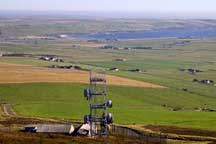Monday 14 November, 2005, 15:19 - Broadcasting
Look at any Frequency Allocation Table (FAT) whether it's the ITU's radio regulations or a national one and there are lots of places where the use of the spectrum changes from one type to another (for example from mobile to fixed links). But what actually happens at the place where the transition takes place? The frequency which marks the transition point between two bands (or sub-bands) is unusable by the users who occupy the spectrum either side. Let's take an example... A stereo FM broadcast transmission occupies a bandwidth of just over 250 kHz. A transmission on a frequency of 108 MHz (the band edge) would therefore have half, i.e. 125 kHz of its bandwidth inside the broadcast allocation and half inside the neighbouring (aeronautical radionavigation) band. Indeed even an FM transmission on 107.9 MHz would still occupy 25 kHz of spectrum above 108 MHz.
 So who can or does use these 'no man's land' frequencies? Well in theory, no-one can, without contravening the band plan that has been put in place. But people do! In fact these frequencies (and those in the neighbourhood) are often occupied by some of the more 'interesting' signals you will find scattered across the radio spectrum.
So who can or does use these 'no man's land' frequencies? Well in theory, no-one can, without contravening the band plan that has been put in place. But people do! In fact these frequencies (and those in the neighbourhood) are often occupied by some of the more 'interesting' signals you will find scattered across the radio spectrum.Around the edges of the broadcasting bands is where you will often find pirate and clandestine stations: the frequency range 6200 - 6300 kHz has long been a short-wave pirate favourite. Such stations typically use much less power than traditional broadcast stations and as such could not compete if they had to battle alongside the MegaWatt signals from stations such as the BBC and Deustche Welle. However at the edge of the band where no-one lives and there are no signals, it's much easier to be heard. Take a look at some of the other frequencies used by pirate stations and you'll almost universally find that they sit roughly on the border between broadcast and non-broadcast users (Laser Hot Hits on 4025 and 9385 kHz for example).
However even the 'big boys' recognise the benefit of sitting in the quiet no man's land at the edge of the broadcast bands. Vatican Radio uses 1611 kHz (edge of the medium wave band); Radio Prague sit on 6200 kHz (edge of the 49 metre band);
 and Radio Pyongyang (North Korea) inhabit both 7100 and 15100 kHz (edge of the 41 and 25 metre bands respectively). Whilst in theory these stations are operating as 'illegally' as the pirates, spewing interference onto other services, they get away with it by the fact that they are 'internationally recognised'.
and Radio Pyongyang (North Korea) inhabit both 7100 and 15100 kHz (edge of the 41 and 25 metre bands respectively). Whilst in theory these stations are operating as 'illegally' as the pirates, spewing interference onto other services, they get away with it by the fact that they are 'internationally recognised'.Take a tune around the band edges (not just the broadcast bands but other ones too) and see what you find...
add comment
( 1258 views )
| permalink
| 



 ( 3 / 8881 )
( 3 / 8881 )




 ( 3 / 8881 )
( 3 / 8881 )

